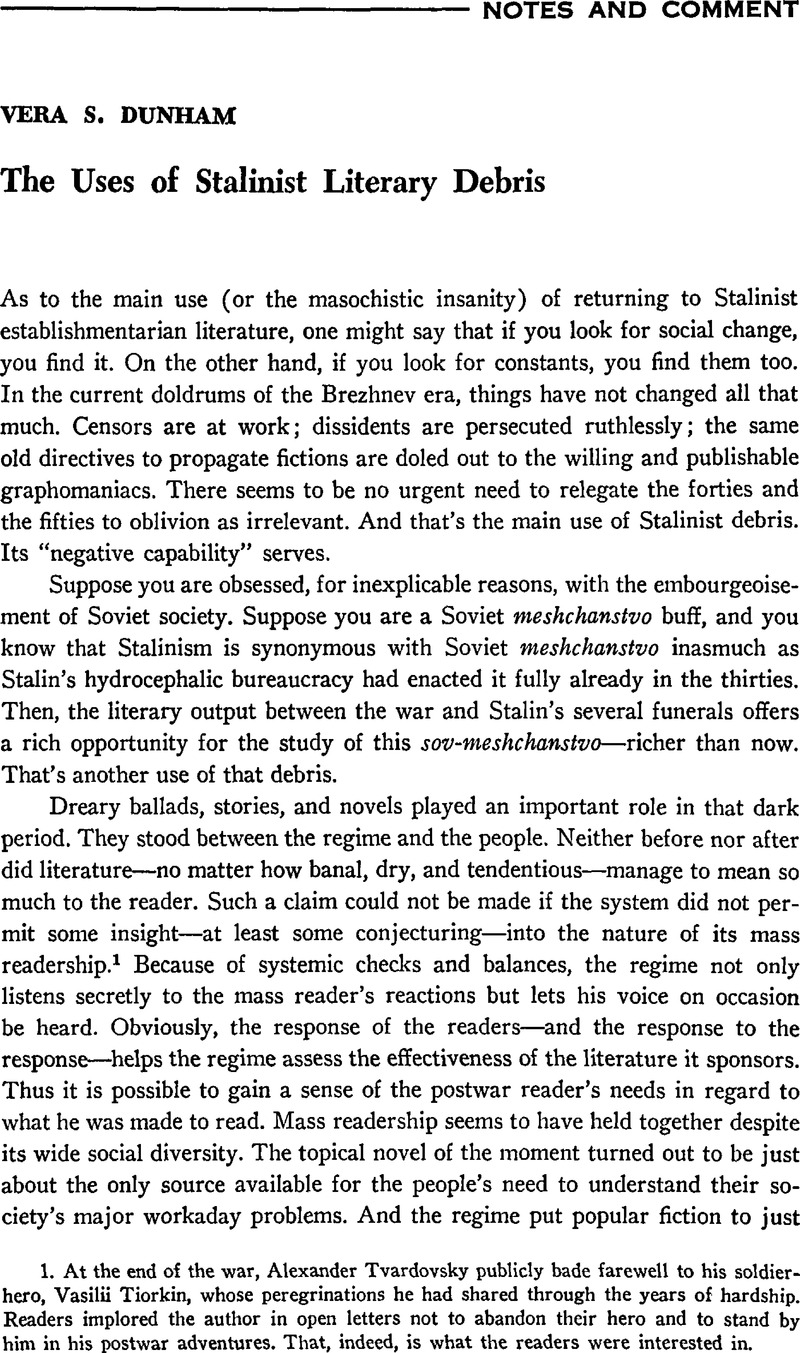Published online by Cambridge University Press: 27 January 2017

1. At the end of the war, Alexander Tvardovsky publicly bade farewell to his soldierhero, Vasilii Tiorkin, whose peregrinations he had shared through the years of hardship. Readers implored the author in open letters not to abandon their hero and to stand by him in his postwar adventures. That, indeed, is what the readers were interested in.
2. Amitai Etzioni distinguishes three forms of compliance which the regime secures from its subjects : coercive (through fear), instrumental (through appeals to self-interest), and normative (neither through fear nor self-interest but through appeals to emotions); A Comparative Analysis of Complex Organizations (New York, 1961), p. S.
3. Mikhail, Isakovsky, “Pesnia o Staline” (1936), Sbornik stikhov (Moscow, 1943), pp. 444–45.Google Scholar
4. Alexander Kron, Kandidat partii, published in Novyi mir, 19S0, no. 10, p. 19.
5. Among the descriptions of socialist realism, Leonid Rzhevsky's seems especially apt, if, alas, not easily translatable : “metod ‘pravdopodobnovo’ izobrazheniia nepravdopodobnykh iavlenii, v ob“ektivnoi deistvitel'nosti otsutstvuiushchikh“; Materialy Konferentsii Nauchnykh Rahotnikov (emtgrantov), sostoiavsheisia v Miunkhene 11-14 ianvaria 1951 g., 6 vols. (Munich, 1951), 6 : 45.
6. The death scene of the party organizer Zernov in A. Gribachev's Vesna v “Pobede,” published in Znamia, 1948, no. 12, p. 49.
7. “Za daliu dal',” in Alexander, Tvardovsky, Sobranie sochinenii, vol. 3 (Moscow, 1952), p. 341.Google Scholar
8. “Utrennie stikhi,” Novyi mir, 1957, no. 4, p. 75.
9. “In-depth” visitors to the Soviet Union today and those close to the’ recent émigrés do not seem to agree on whether the cultural intelligentsia forms anything like a homogeneous group or whether it is bitterly and abrasively splintered, especially from left of center to the extremists. Nor does there seem to be an accord on the matter among the dissidents. Quod erat, alas, demonstrandum.
10. Robert Feldmesser’s provocative “Equality and Inequality Under Khrushchev“ and Seweryn Bialer’s “… But Some Are More Equal than Others” complement each other in a pertinent manner regarding problems of today. Both articles are reprinted side by side in Problems of Communism Anthology : Russia Under Khrushchev, ed. Abraham Brumberg (New York, 1962).
11. Barrington, Moore, Political Power and Social Theory (New York, 1965), pp. 10 and 27.Google Scholar
12. Unbelievable as it may seem in retrospect, Azhaev’s, Polevoy’s, and Bubennov’s overpopulated “epics” were read and responded to.
13. Kondrashov versus Bassargin in Konstantin Sitnonov's Dym otechestva (1947), Uzdechkin versus Listopad in Vera Panova’s Kruzhilikha (1947), and so on, and so on.
14. Once the fearsome notion of pattern is hinted at, the problems of the size of the sample, of intervening variables, and the like come up. This makes the reader who banks on his intuition uneasy. Since Stalinist literature is entirely subservient, it is hard to see where intervening variables could come from. In answer to “How many times?,” one might say that the ghastly uniformity of that literature was underpinned by its mandatory redundance : davai kolkhoz novels, davai anticosmopolitanism plays. In such tightly prefigured straits for central themes and characters, details were derived, obviously, from the same pre-patterned matrix. Details do form patterns, I daresay, if they shape up more than once. And one example is as good as twenty.
15. The very nature and function of postwar partsecs was to stand in the wings. See my ancient “The Party Secretary in Post-War Soviet Literature,” mimeographed (Cambridge, Mass. : Harvard University, 1953).
16. The spirit of party officialdom in, for example, the nasty Skorobogatov in Antonina Koptiaeva's Ivan Ivonovich (1949), and in the party secretary comrade Sukhov (dry, indeed) in Sergei Antonov's “Novyi sotrudnik” (1954), on the one hand, is here juxtaposed with that of humble repentant and neopopulist Pashkov in Iurii Kapusto's V srednem raione (1950) and the disarmingly last-name-less raikomsek Ivan Il'ich with his telling “yellow sickly face and penetrating spark in his eyes” in Grigorii Medynsky's monumental Maria (1949).
17. This keeps Zalkind, one of the last of the positive party Jews, especially busy in Vasilii Azhaev's Daleko ot Moskvy (1948).
18. A good example of the first is Dr. Levin in Iurii German's Podpolkovnik meditsinskoi sluzhby (1949), and of the second, the long-suffering bitter trade union representative Uzdechkin in Panova's Kruzhilikha (1947).
19. The hysterical Korytov in Peter Pavlenko's Schast'e (1947).
20. Oshanin, Lev (1953), in Antologiia russkoi sovetskoi poesii v dvukh tomakh (Moscow, 1957), 2 : 273–76.Google Scholar
21. Nothing, perhaps, is quite so shattering in retrospect as the callous falsehood of bliss and opulence perpetrated in kolkhoz fiction about the ravaged and forgotten villages. One good use—the best, in fact—of the Stalinist literary debris is to remind one of just that.
22. Aleksei Nedogonov, “Flag nad selsovetom,” Novyi mir, 1947, no. 1. The far more capable Mikhail Lukonin might be considered a master of this crucial theme : the retooling of the veteran for postwar chores.
23. Anatolii Sofronov, Kar'era Beketova, published in Novyi mir, 1949, no. 4, pp. 44-89.
24. Alexander, Geveling, “Tania,” Oktiabr, 1950, no. 3, p. 72.Google Scholar
25. Vladimir, Kochetov, Zhurbiny (Moscow, 1952)Google Scholar. It took Evtushenko to speak out against this archetypal meshchanstvo plant in “Stantsiia zima” in the eloquent year of 1956.
26. Pavel Shebunin, Stakhanovtsy, published in Novyi mir, 1950, no. 7, pp. 108-84.
27. The fluffy, contentment-making provincial soprano in Zhanna Gauzer's Vot my i doma, published in Zvezda, 1947, no. 11, pp. 4-106.
28. Kozelsky in Iurii Trifanov's Studenty, published in Novyi mir, 1950, no. 10, pp. 56-175.
29. Solntseva in Anatolii Surov's Rassvet nad Moskvoi, published in Oktiabr', 1951, no. 1, pp. 112-61.
30. Kondratieva in Anatolii Surov's Zelenaia ulitsa, published in Novyi mir, 1949, no. 5, pp. 82-120.
31. Gauzner, Vot my i doma.
32. Trifonov, Studenty.